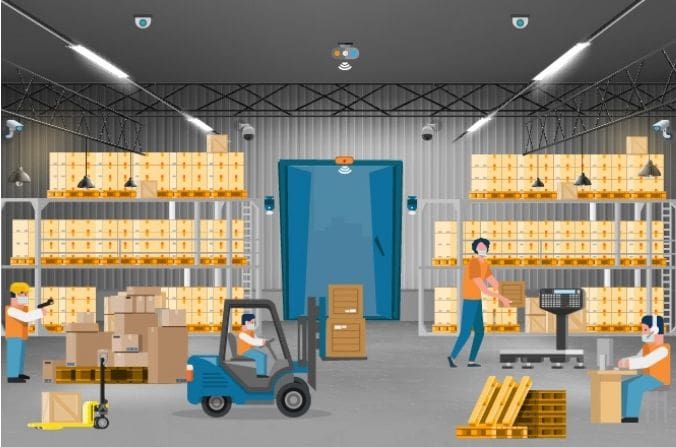How to improve security and efficiency with Warehouse Automation?

Table of Contents
Warehouse automation has been in full force for the past decade, the growth being accelerated due to the unprecedented trends that took over the market with the emergence of the global pandemic. Major companies, wanting to stay ahead of their competitors have not wasted this opportunity in completely reinventing their warehouses with technologically advanced automated systems and an overall secure foundation.
As per the latest post-pandemic market report by LogisticsIQ™ the global warehouse automation market is estimated to grow from USD 15 billion in 2019 and surpass USD 30 billion by 2026, at a CAGR of 14% during the forecast period.
Misconceptions about Warehouse Automation
When we talk about warehouse automation, some inbuilt prejudices against it come to surface, the lack of knowledge and the scope for in depth analysis has left many people thinking that digitizing their store house is more loss inducing than profit making. The idea that upgrading technology is only for bigger enterprises, incurs greater costs to warehousing organizations and once installed requires all devices and processes to be automated; are just a bunch of statements with no research backing them up. Over the years these have resulted in slower transcendence of manually operated warehouses towards automation of their processes.
What automation really means and how it can help warehouses ?
Warehouses and distribution centers, being the midway stations of rest and quality check for products, are always high on running processes, most of them operating round the clock. With the tremendous growth of e-commerce in the last decade, a sudden rush for expanding warehouse facilities over geographical distance as well as in building sizes has ensued. Having grown at a compound annual growth rate (CAGR) of 20% over the last decade, the global e-Commerce sales is expected to reach $7.5 trillion by 2026.
That being said, expansion in physical resources alone is not enough, and has required a management system for a unified and standardized production demographic.
Warehouse Management Systems (WMS) allow employers to surrender a large part of their daily routine tasks to artificial intelligence and machine learning (AI & ML) based solutions, aiding in warehouse automation.
Automation in warehouses has led to an increased number of daily operations being handled by technology, completely riding the process of any unrequited human touch. This digitization of the most basic and routine tasks by warehouses has led to overall efficiency in the performance of warehousing and logistics facilities, while at the same time reducing personnel injury and maintaining safety standards for both the enterprise and the people working in it.
Does your warehouse require automation?
Very often, organizations fail to realize that irrespective of the size of their organization, some level of automation, customizable to their requirements, can enhance their productivity and performance by a great margin. For this, one has to understand that there is more than one level of warehouse automation( the idea of one fits all doesn’t apply here, just as it doesn’t apply to most things).
From simply making data collection automated and allowing other processes to be manually operated, to employing Automated Storage and Retrieval System (AS/RS), Automated Guided Vehicles (AGV), Robotic Picking System and Automatic Palletizers; one can choose their level of warehouse automation according to the requirement of their enterprise.
The difference in the level of automation is also reflected in the price of acquiring and installing the technology at the premises. While the installation cost of smart warehouse management systems is marginally higher than any other manually operated system, its return on investment(ROI) brings a completely different story home. From reduction in errors and injuries as well as lesser staff members to remunerate to quicker and more accurate task fulfilment and standardized processes over all the sites, warehouse automation systems consistently bring greater returns in comparison to conventional supervision.
Even for smaller warehouses, using smart solutions to automate a certain part of their processes rather than the complete process proves to be fruitful as long as the tasks are made easier and their performance accurately swifter.
Process Automation
Warehouse automation comes in varying degrees of purpose and scope of application, targeting different areas of specialization. From inbound to outbound, a warehousing and logistics facility is indulged in a multitude of processes that can benefit from the utility of an AI and ML based solution.
Inventory Management
Every warehouse deals with large quantities of assets and inventory; requiring a systematic placement and execution solution for the safe and efficient management of all resources.
These smart systems not only keep a check on how the inventory is managed but also provides the staff with placement recommendations to optimize space utility and easier access to more frequently demanded products.
Product Receiving/Shipping
When it comes to warehouse automation, its requirement is most strongly felt at the loading and unloading docks, which along with being high traffic areas, can turn out to be a dangerous place of transition for employees and assets if not handled with care. The products coming in and going out need to go through a number of code scans and quality checks before they can be stored or shipped out. In both cases, manually carrying out these processes can be extremely time consuming, and lets not forget, extremely dangerous for employees operating vehicle restraints, levelers and overhead doors.
Product Handling/Storage
Facilitation centers that act as inertial stops for products between manufacturing units and consummating units or other storage centers have to be utility proof, ensuring the safe storage of brittle and volatile products. Their movement from the unloading docks to the storage unit and back, must, thus, be assisted with great care. Warehouse automation system allows these processes to go error free, marginally reducing the chance of employee injury.
Sorting/Picking/Packing
Sorting products by identifying and diverting them to specific destinations depending upon their types or batch numbers, picking products according to their specifications (panel number, batch number, shelf number) and consolidating multiple orders within the same packing station to be shipped in the same carton can be made swift and more accurate by using a variety of devices controlled by task specific software.
Warehouse Automation and Security
While warehouse management systems bring standardization over the processes while providing a buildable and scalable platform, providing organizations with the scope of growing with rising customer demands and applications of newer and better technology; one major aspect of this system is that of the security it provides to an enterprise. From smart sensors and internet protocol(IP) cameras sending real-time updates on a unified cloud based platform to a vigilant command center interface, organizations are able to maintain the inviolability of the warehouses by monitoring absolute control over the performance of all their sites.
Conclusion
Warehouse and inventory management has been majorly impacted by the technological advancements in the recent years, turning to automating daily tasks for an efficiently performing enterprise, while at the same time strengthening the security structure. From complete automation to partial or process based warehouse automation, enterprises have been able to customize these solutions with respect to their size, capital limitations as well as security requirements. Having touched every process that goes on inside and around a warehousing facility, this trend of rooting daily tasks onto self sufficient technology has been able to create an environment of integration, allowing employees in a facility to shift physically exhaustive tasks onto machines and employing their time on more mind oriented tasks.
Interested in knowing how IGZY can help you overcome your business challenges? Contact us today.





